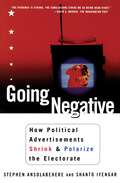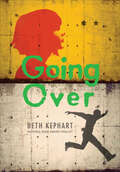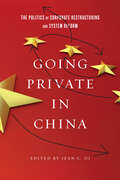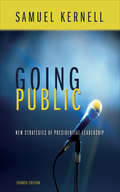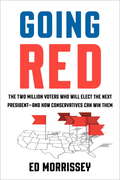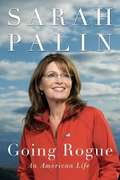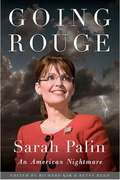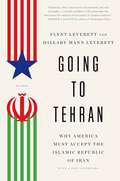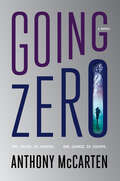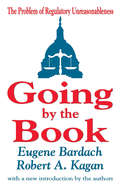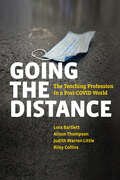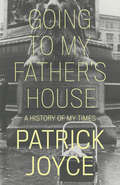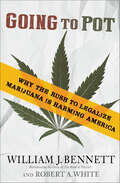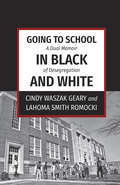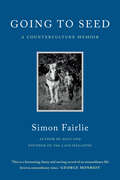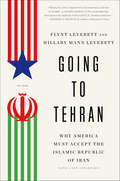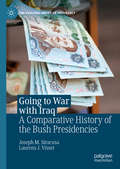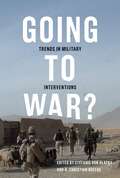- Table View
- List View
Going Negative: How Political Advertisements Shrink & Polarize the Electorate
by Shanto Iyengar Stephen AnsolabeherePolitical advertising has been called the worst cancer in American society. Ads cost millions, and yet the entire campaign season is now filled with nasty and personal attacks. In this landmark six-year study, two of the nation's leading political scientists show exactly how cancerous the ad spot has become. 16 illustrations.
Going Nowhere, Slow: The Aesthetics and Politics of Depression
by Mikkel Krause FrantzenUsing examples from art and literature, Frantzen explores the social, political and economic implications of both real and imagined depression. Is feeling blue a symptom of the death of progress? Was the suicide of David Foster Wallace a proverbial canary in a coal mine? Margaret Thatcher once declared that there is no alternative to the social order that we now reside within. Have we accepted her slogan as a fact, and is that why so many are on Prozac and other anti-depressants? Frantzen examines the works of Michel Houellebecq, Claire Fontaine and David Foster Wallace as he seeks out an answer and a way to formulate a new future oriented left movement.
Going Over
by Beth KephartIt is February 1983, and Berlin is a divided city with a miles-long barricade separating east from west. But the city isn't the only thing that is divided. Ada lives among the rebels, punkers, and immigrants of Kreuzberg in West Berlin. Stefan lives in East Berlin, in a faceless apartment bunker of Friedrichshain. Bound by love and separated by circumstance, their only chance for a life together lies in a high-risk escape. But will Stefan find the courage to leap? Or will forces beyond his control stand in his way? National Book Award finalist Beth Kephart presents a story of daring and sacrifice, and love that will not wait.
Going Private in China: The Politics of Corporate Restructuring and System Reform
by Jean C. OiAs the Chinese Communist Party (CCP) set about reforming its centrally planned economy, it faced the thorny policy question of how to reform its state-owned enterprises (SOEs). Should it support a shift from public to private ownership of the means of production? Such a shift would challenge not only the CCP's socialist ideology but also its very legitimacy. Mixing the business of corporate restructuring with the politics of socialism presented nothing short of a policy nightmare. With policy-relevant acuity, the contributors to this wide-ranging volume address the questions about reform programs that have plagued China—and East Asia more broadly—since the 1990s. While China, Japan, and South Korea have all been criticized for implementing reform too slowly or too selectively, this volume delves into the broader contexts underlying certain institutional decisions. The book seeks to show that seemingly different political economies actually share surprising similarities, and problems. While Going Private in China sheds new light on China's corporate restructuring, it also offers new perspectives on how we think about the process of institutional change.
Going Public: New Strategies of Presidential Leadership
by Samuel H. KernellPresidents are uniquely positioned to promote themselves and their polices directly to the public. Using sympathetic crowds as a backdrop, a president can rally public opinion to his side, along the way delivering a subtle yet unmistakable message to his intended audience in Congress. Samuel Kernell shows how “going public” remains a potent weapon in the president’s arsenal, both for advancing his own agenda and blocking initiatives from his political adversaries in Congress.In his highly anticipated fourth edition, Kernell delivers thorough analysis and detailed background on how this strategy continues to evolve given the intense polarization of Congress and the electorate as well as changes in communications technology. He considers the implications of both factors—especially in combination—on the future of presidential leadership and weighs the lessons of 9/11 on “going public” in foreign affairs.
Going Red: The Two Million Voters Who Will Elect the Next President--and How Conservatives Can Win Them
by Ed MorrisseyThe 2016 election is conservatives' last, best chance to take back the country. How can they win? The answer, conservative columnist and analyst Ed Morrissey says, depends on seven battleground counties in swing states Republicans must win. Each county pulled for Obama in one or both of the last two elections, but after eight years of misadventures under the Obama administration, the door is open for Republicans to win them--and the presidency--once again, making a decisive mandate against progressivism for the generation to come. In Going Red, Morrissey takes readers inside the battlegrounds that will decide the election, weaving together data and the stories of people and leaders in these communities to answer the most pressing questions facing conservatives in 2016: - What went wrong in 2008 and 2012, and how can the party do better in 2016?- Can Republicans take back crucial swing states like Florida, Ohio, and Virginia?- Is a Hillary Clinton victory really inevitable? - How can conservatives reverse their track record with minorities and young voters? Providing an unparalleled look into the campaign and the thinking of experts from both parties, Going Red is a field guide for taking back the White House and an essential book for anyone who cares about the fate of the Right.From the Hardcover edition.
Going Rogue: An American Life
by Sarah PalinFrom her humble beginnings to her time in the spotlight as the first female Republican Vice President candidate, Sarah Palin has led an extraordinary life. Going Rogue will recount her political experiences, her time as Mayor of Wasilla and as the first female governor of Alaska, as well as her rapid rise on the national stage during the 2008 campaign. Additionally, she'll share insights into the personal challenges she's faced including balancing her time as a working mother, recognizing the war's impact with her son serving combat in Iraq, having a child with a disability, and supporting her teenage daughter with an unplanned pregnancy.
Going Rogue: An American Life
by Sarah PalinGoing Rogue is the #1 New York Times bestselling memoir from Sarah Palin, one of America’s most beloved and controversial political figures. Now with new material, Going Rogue offers plain talk from a true American original about her life, her career, and the future of the country she loves.
Going Rouge: Sarah Palin--An American Nightmare
by Richard Kim Betsy ReedSarah Palin has many faces: hockey mom, fundamentalist Christian, sex symbol, Republican ideologue, fashion icon, "maverick" populist. But, above all, Palin has become one thing: an American obsession that just won't go away. Edited by two senior editors at 'The Nation' magazine, this sharp, smart, up-to-the-minute book examines Palin's quirky origins in Wasilla, Alaska, her spectacular rise to the effective leadership of the Republican Party, and the nightmarish prospect of her continuing to dominate the nation's political scene. With contributions by: Amy Alexander, Max Blumenthal, Juan Cole, Joe Conason, Jeanne Devon, Eve Ensler, Michelle Goldberg, Jane Hamsher, Christopher Hayes, Mark Hertsgaard, Jim Hightower, Linda Hirshman, Naomi Klein, Dahlia Lithwick, Amanda Marcotte, Shannyn Moore, John Nichols, Rick Perlstein, Tom Perrotta, Katha Pollitt, Robert Reich, Frank Rich, Hanna Rosin, Jeff Sharlet, Matt Taibbi, Michael Tomasky, Rebecca Traister, Katrina vanden Heuvel, Jessica Valenti, Patricia Williams, JoAnn Wypijewski and Gary Younge among others.
Going To Tehran: Why America Must Accept The Islamic Republic Of Iran
by Flynt Leverett Hillary Mann LeverettA FOREIGN POLICY MAGAZINE BOOK TO READ Less than a decade after Washington endorsed a fraudulent case for invading Iraq, similarly misinformed and politically motivated claims are pushing America toward war with Iran. Challenging the daily clamor of American saber rattling, Flynt and Hillary Mann Leverett argue that America should renounce thirty years of failed politics, diplomacy and strategy and engage with Iran―just as Nixon revolutionized U.S. foreign policy by going to Beijing and realigning relations with China. In Going to Tehran, former analysts in both the Bush and Clinton administrations, the Leveretts offer a uniquely informed account of Iran as it actually is today, not as many have caricatured it or wished it to be. They show that Iran's political order is not on the verge of collapse, that most Iranians still support the Islamic Republic, and that Iran's regional influence makes it critical to progress in the Middle East. Drawing on years of research and access to high-level officials, the Leveretts' indispensable work makes it clear that America must "go to Tehran" if it is to avert strategic catastrophe.
Going Zero: A Novel
by Anthony McCartenTWO HOURS TO VANISH.ONE CHANCE TO ESCAPE.ZERO ALTERNATIVES.Ten Americans have been carefully selected to Beta test a ground-breaking piece of spyware. FUSION can track anyone on earth. But does it work?For one contestant, an unassuming Boston librarian named Kaitlyn Day, the stakes are far higher than money, and her reasons for entering the test more personal than anyone imagines. When the timer hits zero, there will only be one winner…From four-time Academy Award-nominated screenwriter Anthony McCarten comes a breakneck, wickedly entertaining thriller for our times, a twisty, action-packed novel reminiscent of the best Michael Crichton technothrillers.
Going beyond Parochialism and Fragmentation in the Study of International Relations (IR Theory and Practice in Asia)
by Yong-Soo EunInternational Relations (IR), as a discipline, is a western dominated enterprise. This has led to calls to broaden the scope and vision of the discipline by embracing a wider range of histories, experiences, and theoretical perspectives – particularly those outside the Anglo-American core of the West. The ongoing ‘broadening IR projects’ – be they ‘non-Western IR’, ‘post-Western IR’, or ‘Global IR’ – are making contributions in this regard. However, some careful thinking is needed here in that these attempts could also lead to a national or regional ‘inwardness’ that works to reproduce the very parochialism that is being challenged. The main intellectual concerns of this edited volume are problematising Western parochialism in IR; giving theoretical and epistemological substance to pluralism in the field of IR based on both Western and non-Western thoughts and experiences; and working out ways to move the discipline of IR one step closer to a dialogic community. A key issue that cuts across all contributions in the volume is to go beyond both parochialism and fragmentation in international studies. In order to address the manifold and contested implications of pluralism in in the field of IR, the volume draws on the wealth of experience and research of prominent and emerging IR scholars whose contributions make up the work, with a mixture of theoretical analysis and case studies. This book will appeal to scholars and students interested in Global IR and promoting dialogue in a pluralist IR.
Going by the Book: The Problem of Regulatory Unreasonableness
by Walter KaufmannThe extent to which government should be involved with regulation in the private sector is much debated. More fundamentally, one might ask exactly what is regulation, why is it needed, how is it formulated, and how is it enforced? These questions are especially relevant at a time in United States history when federal involvement in spheres traditionally left to individuals is being widely debated on all sides of the political spectrum.
Going for Counselling: Working with your counsellor to develop awareness and essential life skills
by William StewartThis book explores the counselling process and will help you to choose a counsellor to suit your needs. Counselling isn't always problem centred. It can enable you to develop self-awareness and introduce you to ways in which you can manage your life more effectively. This book will show you how.
Going the Distance: The Teaching Profession in a Post-COVID World
by Lora Bartlett Judith Warren Little Alisun Thompson Riley CollinsAn unflinching yet ultimately hopeful appraisal of the workplace factors that determine career risk and resilience among K–12 teachers, informed by the lessons of the COVID-19 crisis
Going to Gaza: Ten Days that Changed the World
by Colin MallardGoing to Gaza, Ten Days That Changed the World, weaves an amazing story set in one of the most persistent conflict areas of the world. Our inability to solve this conflict has undoubtedly contributed to the rise of violent religious fundamentalism. What can we do? Seventy years of continuous war suggests we haven't found the solution. What if we tried something else, something really different, something never tried before? Going to Gaza is about such an undertaking. It is an exciting and suspenseful story, a sequel to the award winning book, Stillpoint, a novel of war, peace, politics and Palestine. The events described in Going to Gaza are a combination of fact and fiction, of beautiful dreams and ugly realities--reflections of us, our nature as human beings.
Going to Hell to Get the Devil: The 1972 Charlotte Three Case and the Freedom Struggle in a Sunbelt City (Making the Modern South)
by J. Christopher SchutzThe 1968 burning of the Lazy B Stables in Charlotte, North Carolina, attracted little notice beyond coverage in local media. By the mid-1970s, however, the fire had become the center of a contentious and dubious arson case against a trio of Black civil rights activists, who became known as the “Charlotte Three.” The charges against the men garnered interest from federal law enforcement agents, investigative journalists— including one who later earned a Pulitzer Prize for coverage of the trials—numerous New Left and Black Power activists, and Amnesty International, which declared the defendants “political prisoners.” In Going to Hell to Get the Devil, J. Christopher Schutz offers the first comprehensive examination of this controversial case and its outcome. In the 1960s and 1970s, Charlotte’s leaders sought to portray their home as a placid, business-friendly, and racially moderate community. When New Left and Black Power activists threatened that stability, city leaders employed a variety of means to silence them, including the use of law enforcement against African Americans they deemed too zealous. In the Charlotte Three case, prosecutors paid prisoners for testimony against the Black activists on trial, resulting in their convictions with lengthy prison sentences. The unwanted publicity surrounding the case of the Charlotte Three became a critical pivot point in the Queen City’s post–World War II trajectory. Going to Hell to Get the Devil tells more than the story of an arson case; it also tells the story of the South’s future, as the fate of the Charlotte Three became emblematic of the decline of the African American freedom struggle and the causes it championed.
Going to My Father's House: A History of My Times
by Patrick JoyceA historian's personal journey into the complex questions of immigration, home and nationFrom Ireland to London in the 1950s, Derry in the Troubles to contemporary, de-industrialised Manchester, Joyce finds the ties of place, family and the past are difficult to break. Why do certain places continue to haunt us? What does it mean to be British after the suffering of Empire and of war? How do we make our home in a hypermobile world without remembering our pasts?Patrick Joyce's parents moved from Ireland in the 1930s and made their home in west London. But they never really left the homeland. And so as he grew up among the streets of Paddington and Notting Hill and when he visited his family in Ireland he felt a tension between the notions of home, nation and belonging. Going to My Father's House charts the historian's attempt to make sense of these ties and to see how they manifest in a globalised world. He explores the places - the house, the street, the walls and the graves - that formed his own identity. He ask what place the ideas of history, heritage and nostalgia have in creating a sense of our selves. He concludes with a plea for a history that holds the past to account but also allows for dynamic, inclusive change.
Going to Pot: Why the Rush to Legalize Marijuana Is Harming America
by William J. Bennett Robert A. WhiteWilliam J. Bennett, former director of the National Drug Control policy under President George H.W. Bush and bestselling author of The Book of Virtues, and co-author Robert White provide strong societal and scientific arguments against the legalization of marijuana. Marijuana, once considered worthy of condemnation, has in recent years become a "medicine," legalized fully in four states, with others expected to follow. But the dangers are clear. According to Bennett's research, more Americans are admitted to treatment facilities for marijuana use than for any other illegal drug. Studies have shown a link between marijuana use and abnormal brain structure and development. From William Bennett comes a call-to-action for the 46 states that know better than to support full legalization, and a voice of reason for millions who have jumped on the legalization bandwagon because they haven't had access to the facts.
Going to School in Black and White: A dual memoir of desegregation
by Cindy Waszak Geary Lahoma Smith Romocki"The challenges of identity, assimilation, achievement, and politics that were faced by Lahoma and Cindy are the same challenges our youth are facing today." –Jaki Shelton Green, poet and NC Literary Hall of Fame inducteeThe school careers of two teenage girls who lived across town from each other—one black, one white—were altered by a court-ordered desegregation plan for Durham, NC in 1970. LaHoma and Cindy both found themselves at the same high school from different sides of a court-ordered racial “balancing act.” This plan thrust each of them involuntarily out of their comfort zones and into new racial landscapes. Their experiences, recounted in alternating first person narratives, are the embodiment of desegregation policies, situated in a particular time and place. Cindy and LaHoma’s intertwining coming of age stories are part of a bigger story about America, education and race—and about how the personal relates to the political.This dual memoir covers the two women’s life trajectories from early school days to future careers working in global public health, challenging gender biases, racial inequities, and health disparities. LaHoma and Cindy tell their stories aware of the country's return to de facto school segregation, achieved through the long-term dismantling of policies that initially informed their school assignments. As adults, they consider the influence of school desegregation on their current lives and the value of bringing all of us into conversation about what is lost or gained when children go to school in black and white.
Going to Seed: A Counterculture Memoir
by Simon FairlieAn unforgettable firsthand account of how the hippie movement flowered in the late 1960s, appeared spent by the Thatcher-consumed 1980s, yet became the seedbed for progressive reform we now take for granted—and continues to inspire generations of rebels and visionaries. "Fairlie has a refreshingly declarative style: he’s analytical, funny and self-aware. . . His memoir has much to offer anyone interested in movement history or in the future of intentional communities."—Elizabeth Royte, Food & Environment Reporting Network At a young age, Simon Fairlie rejected the rat race and embarked on a new trip to find his own path. He dropped out of Cambridge University to hitchhike to Istanbul and bicycle through India. He established a commune in France, was arrested multiple times for squatting and civil disobedience, and became a leading figure in protests against the British government’s road building programs of the 1980s and—later—in legislative battles to help people secure access to land for low impact, sustainable living. Over the course of fifty years, we witness a man’s drive for self-sufficiency, freedom, authenticity, and a deep connection to the land. Fairlie grew up in a middle-class household in leafy middle England. His path had been laid out for him by his father: boarding school, Oxbridge, and a career in journalism. But everything changed when Simon’s life ran headfirst into London’s counterculture in the 1960s. Finding Beat poetry, blues music, cannabis and anti–Vietnam War protests unlocked a powerful lust to be free. Instead of becoming a celebrated Fleet Street journalist like his father, Simon became a laborer, a stonemason, a farmer, a scythesman, and then a magazine editor and a writer of a very different sort. In Going to Seed he shares the highs of his experience, alongside the painful costs of his ongoing search for freedom—estrangement from his family, financial insecurity, and the loss of friends and lovers to the excesses and turbulence that continued through the 70s and 80s. Part moving, free-wheeling memoir, part social critique, Going to Seed questions the current trajectory of Western “progress”—and the explosive consumerism, growing inequality, and environmental devastation laid bare in our daily newsfeeds—and will resonate with anyone who wonders how we got to such a place. Simon’s story is for anyone who wonders what the world might look like if we began to chart a radically different course.
Going to Tehran: Why America Must Accept the Islamic Republic of Iran
by Flynt Leverett Hillary Mann LeverettAn eye-opening argument for a new approach to Iran, from two of America's most informed and influential Middle East expertsLess than a decade after Washington endorsed a fraudulent case for invading Iraq, similarly misinformed and politically motivated claims are pushing America toward war with Iran. Today the stakes are even higher: such a war could break the back of America's strained superpower status. Challenging the daily clamor of U.S. saber rattling, Flynt and Hillary Mann Leverett argue that America should renounce thirty years of failed strategy and engage with Iran—just as Nixon revolutionized U.S. foreign policy by going to Beijing and realigning relations with China.Former analysts in both the Bush and Clinton administrations, the Leveretts offer a uniquely informed account of Iran as it actually is today, not as many have caricatured it or wished it to be. They show that Iran's political order is not on the verge of collapse, that most Iranians still support the Islamic Republic, and that Iran's regional influence makes it critical to progress in the Middle East. Drawing on years of research and access to high-level officials, Going to Tehran explains how Iran sees the world and why its approach to foreign policy is hardly the irrational behavior of a rogue nation. A bold call for new thinking, the Leveretts' indispensable work makes it clear that America must "go to Tehran" if it is to avert strategic catastrophe.
Going to War with Iraq: A Comparative History of the Bush Presidencies (The Evolving American Presidency)
by Joseph M. Siracusa Laurens J. VisserGoing to War with Iraq: A Comparative History of the Bush Presidencies is the account of two United States presidents and their decision to intervene militarily in Iraq, examining the comparative domestic and international contexts in which the decisions to go to war were made by George H. W. Bush and his son George W. Bush. This book centers specifically on the issue of Saddam Hussein at home and abroad, in the lead up to hostilities with Iraq in 1991 and 2003, respectively. For George H.W. Bush, in 1991, the threat posed by Saddam came from his perceived capabilities as Iraq's leader, whereas for George W. Bush, in 2003, it was the threat posed by Saddam's perceived intentions as Iraq's leader. In both cases, the result was war with Iraq.
Going to War with the Other: A Study of U.S. Foreign Policies of Violence
by Evan O. RenfroThe objective of this book was to use Edward Said's theory Orientalism in order to increase our understanding of such how and why the United States goes to war in the manner in which it has and does. I examined all cases of United States foreign policies of overt violence, bounded by and including, Vietnam (1964-1969) and Iraq (2003-2007). What this research showed was quite contrary to Orientalism’s expectations (as well as my own). Analyzing the discursive record for the “trigger words” that should be present if Orientalist frames were used in the making/applying of US foreign policy resulted in conclusions that are not only largely unsupportive, but in some cases detrimental to the theory. While I cannot categorically deny the existence of any supportive evidence for Orientalism, there is clearly no extant pattern of such ideological discourse in any examined cases. The only exception to this is germane to the last case study, Afghanistan (2001-2003). In this case, I argued that what we are seeing is an outlier, created by a sui generis action, viz., a traumatizing terrorist attack on US soil. Instead of Orientalism, what the record shows are examples of what I’ve termed “neutral-Orientalism” and “anti-Orientalism.” The former are cases where Orientalist trigger words are present in the discourse, but they do only prosaic duty. Such lexical choices are a-ideological, often providing definitional work in the contexts considered. “Anti-Orientalism,” which is actually more common than Orientalism, is when the trigger words work in precisely the opposite way from which the theory would suggest. The evidence uncovered in this book suggests a renewed caution when dealing with questions of Orientalism, and a more robust consideration of the empirical record.
Going to War?: Trends in Military Interventions
by H. Christian Breede Stéfanie Von HlatkyGoing to War? investigates the reasons why countries enter conflicts by considering the depth and complexity of issues surrounding military deployments. Showing how such conditions affect future decisions about the use of force, contributors to this volume study recent experiences with military interventions - such as regional flash points, the global financial crisis, and public weariness - to outline the crucial factors that influence wartime decision-making. Through detailed discussion of threats, capabilities, trends, and the implications of Canada's and NATO's military experiences abroad, Going to War? determines that the reasons for warfare have as much to do with domestic concerns as they do with international threats. With essays by defence scientists, established and emerging scholars, and senior military officers from Germany, the United States, and Canada, this volume includes debates on whether the number of military fatalities is being reduced, war's changing character, and the ways in which the improvised explosive device has and will continue to challenge modern, advanced militaries deployed abroad, especially in Afghanistan and Iraq. A sophisticated exercise in foreign and defence policy analysis, Going to War? provides clear and vivid ideas on how to optimize future Western military interventions.
